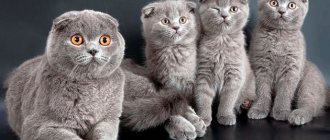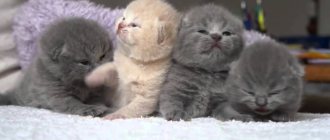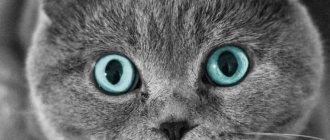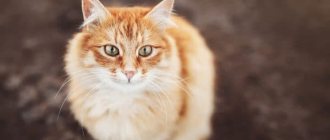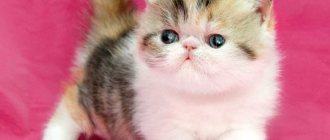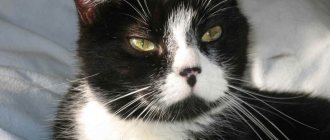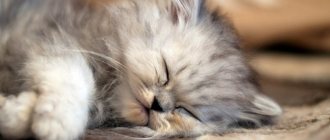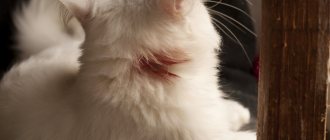Natural predisposition
Among the many cat breeds, there are brachycephalic varieties, which have a skull structure that is atypical for other species. These are the well-known Persian and British cats, as well as their mestizos, which are characterized by a “flat” muzzle and a shortened head shape. Due to abnormal physiology, such animals have :
- frequent colds during the cold season;
- difficulty breathing in hot weather;
- low filtration ability, so dust and other small particles have a sharp irritating effect;
- violations of the structure of the soft palate, which interfere with normal air flow.
© shutterstock
A cat's characteristic grunt accompanies each of the described situations. In everyday life they snore and wheeze. A cat may sneeze when it has a cold or in dusty rooms. The abnormal shape of the palate not only makes breathing difficult, but also provokes vomiting. The only solution to the problem can be surgery.
What to do if your cat has a runny nose?
The smartest thing to do is take the cat to a veterinary clinic or call a doctor at home. Self-treatment will not be effective without a diagnosis, and in the case of infections, a common runny nose can be fatal.
A runny nose in cats is not contagious to humans, but when in contact with a pet, especially when washing the nasal passages with your own hands, you must follow simple hygiene rules.
How to rinse a cat's nose? The following solutions are effective:
- Saline solution (9%).
- Saline (1 tsp salt per 1 liter of water).
- Boric acid (2-3%).
- Zinc sulfate (0.5-1%).
- Furacillin (tablet per glass).
- Dioxidine (0.5%, buy 1% solution at the pharmacy and dilute twice).
- Soda (1\2 tsp soda per 0.5 l of water).
The order of application of the solution, frequency of use and for what pathologies is decided by the doctor.
The cat is secured by wrapping it tightly in a towel, leaving only its head outside. Place a solution (0.5 ml) into a syringe without a needle and carefully pour it into the nostril. Do not press the piston too hard; remove the leaking liquid with napkins. When you sneeze and snort, deeply localized mucus will come out.
General strengthening treatment is necessary to strengthen the cat’s immunity and help it cope with the underlying disease. Gamavit (0.3-0.5 ml/kg), Fosprenil, Immunofan, Ribotan are prescribed.
It is necessary to cure a runny nose in a cat; this is a symptom that should not be ignored and expect that it will go away on its own without consequences for the animal’s health.
Paroxysmal breathing
Every owner has at least once witnessed a situation where a cat grunts, sneezes and tries to breathe in air at the same time. At the same time, her eyes are wide open, she arches her back and presses her front paws to her chest. Veterinarians describe this condition as paroxysmal breathing. For the most part, it does not pose any threat, but you should be wary if :
- the frequency of attacks increases over a short period of time;
- a secondary symptom is vomiting, especially with blood;
- The cat began to sleep restlessly and seemed to be suffocating in his sleep.
Not only cats, but also dogs suffer from this. Attacks can be considered rare if they occur no more than 1-2 times a month. If the problem begins to bother you every day, you need to consult a doctor as soon as possible.
© shutterstock
Why is mucus formed?
The production of mucous masses by the nasopharynx is a natural phenomenon. They perform a moisturizing and protective function. Mucous masses trap foreign particles, pollen, and bacteria that enter with the air and prevent them from descending lower into the trachea and lungs. As soon as these foreign agents enter the mucous membranes, the amount of secretion produced increases, and the person has a desire to clear his nose or cough. When the irritant is removed from the body, secretion production returns to its previous level.
Normally, a person does not notice the process of formation of mucous masses - they are swallowed along with saliva.
The accumulation of mucus in the throat becomes noticeable when it is produced continuously and thickens. The patient directly feels how mucous masses flow along the back wall of the pharynx and accumulate in it. During the daytime, the accumulation of sputum is not so disturbing - it is swallowed and does not greatly irritate the cough receptors. But if you take a horizontal position, for example, at night while sleeping, the mucous masses cannot freely pass inside and stagnate in the throat. This causes severe coughing attacks, which can even provoke vomiting.
When a person comes to an otolaryngologist and says: “I constantly swallow mucus in my throat,” the first thing the ENT doctor will do is find out why mucus accumulates in the throat.
Only after establishing the true cause of mucus in the throat, it will be possible to prescribe the correct treatment.
Helminthiasis
Extensive parasite infestation may explain why the cat grunts. Some types of worms develop in the lungs. By feeding on blood, tissues and multiplying in the respiratory tract, helminths provoke the occurrence of an inflammatory process and the formation of pathogenic microflora. As a result, the cat develops breathing problems accompanied by grunting.
In advanced stages, grunting and coughing result in vomiting, in which live parasites can be found. Treatment of pets with anthelmintic drugs should be carried out not only for therapeutic, but also for preventive purposes.
Runny nose in cats: main causes
Correct diagnosis is an integral part of therapy; it will not be successful without determining the cause of the runny nose. The symptom accompanies the following pathological conditions:
- Infectious diseases.
A runny nose will occur with viral rhinotracheitis (herpervirus), calicivirus infection. The diseases are seasonal, with frequent exacerbations occurring in spring and autumn. The source of infection is sick animals, virus carriers. The first symptoms of illness appear after 2-10 days, depending on the disease, immunity, age of the cat and concomitant pathologies.
The cat has a runny nose and watery eyes. There is a bilateral discharge from the nose, initially of a serous-mucous nature, then the exudate thickens, becomes purulent, and discharge from the eyes appears. The animal is apathetic, refuses to eat, has an elevated temperature, and is sneezing. If left untreated, the oral mucosa and conjunctiva ulcerate.
The diagnosis is made based on symptoms (runny nose, sneezing), laboratory tests (PCR, serological tests). The treatment is long-term, immunoglobulins, broad-spectrum antibiotics, immunomodulators, and vitamins are prescribed. The nose, mouth and eyes are washed with antiseptic solutions, and cold drops for cats are used to make breathing easier.
The development of calicivirus infection and viral rhinotracheitis can be prevented with timely vaccination.
- Bacterial infections.
A runny nose in cats occurs with mycoplasmosis, chlamydia, and bordetellosis. Chronic runny nose (rhinitis) in a cat and sinusitis develop after viral infections or deformation of the sinuses. Typical symptoms: unilateral or bilateral nasal discharge, sneezing, conjunctivitis (severe in chlamydia), cough (bordetellosis).
Treatment is complex, immunomodulators and antibiotics are prescribed. For bordetellosis, fluoroquinol drugs are effective; for mycoplasmosis and chlamydia, macrolides and tetracyclines are effective.
Mycoplasmosis, chlamydia (opportunistic microflora) are prevented by good nutrition, keeping the animal, and timely treatment of pathologies leading to chlamydial immunosuppression.
Bordetellosis in cats, or “kennel cough,” spreads quickly when animals are kept in crowded conditions without sanitary standards. It is characterized by sinusitis, chronic rhinitis, bilateral, purulent nasal discharge, respiratory failure, and sneezing. The general condition of the animal with bordetellosis is satisfactory, there is no appetite.
- Neoplasms.
Tumors of a benign and malignant nature form in the nasal cavity. Nasopharyngeal polyps, adenocarcinoma, lymphosarcoma, osteo- and fibrosarcoma are diagnosed. With benign neoplasms (polyps), a runny nose of a mucopurulent nature, breathing and swallowing are difficult, the cat sneezes. Treatment – removal of polyps, prevention of their appearance through timely treatment of inflammatory processes in the upper respiratory tract.
In the case of malignant formations, the nature of nasal discharge changes, the discharge is one or bilateral, initially mucous, changing to purulent and hemorrhagic. There is swelling of the muzzle and deformation of the sinuses. The treatment is complex, chemotherapy, surgery, combined treatment are prescribed, it all depends on the histotype of the tumor, the complexity of the pathological process, and the age of the cat.
- Injuries.
Cats have a runny nose when struck, resulting in a cleft palate (fall from a height) and the development of chronic rhinitis. Often the symptom is a runny nose, this is the result of injury to the nasal cavity by a foreign object.
With a cleft palate, nasal discharge is bilateral, mixed with food. Treatment is surgery, surgical plastic surgery is performed to eliminate the cleft. The discharge is serous, mucous, then purulent due to a foreign body in the nose. Treatment is removal of foreign inclusions, antibiotic therapy and prevention of the development of secondary infection.
- Mycoses.
Fungal infections are rarely diagnosed in cats; an example is cryptococcosis. The disease is characterized by unilateral or bilateral runny nose, deformation of the facial part of the skull. During treatment, systemic antimycotic agents are prescribed that are active against yeast-like fungi. Mycoses often accompany diseases that provoke immunodeficiency in cats - viral leukemia, viral immunodeficiency.
Urinary tract diseases in Scottish Fold cats
Adult and castrated animals are prone to developing diseases of the genitourinary system. These include:
- idiopathic cystitis;
- urolithiasis disease;
- obstruction of the urethra in males and females.
The similarity of the symptoms of these diseases does not allow owners of Scottish Fold cats to independently make an accurate diagnosis. Therefore, consulting a doctor is necessary if the following clinical signs occur:
- pain when urinating, expressed by meowing or unnatural posture of the animal;
- increase or decrease in the number of acts of urination per day;
- the appearance of blood in the urine;
- cloudy urine;
- increased (changed) smell of urine;
- general lethargy, loss of appetite, inactivity.
Treatment for Scottish Fold cats depends on the type and stage of the disease and is prescribed only by a veterinarian.
To maintain the health of Scottish cats by preventing the formation of crystals and the development of inflammation, the following prevention methods are used:
- introduction of wet food into the diet;
- ensuring constant access to fresh water;
- preventing obesity;
- encouraging physical activity.
Since Scottish Fold cats have a predisposition to urological diseases, it is recommended to have their urine analyzed once every six months for timely detection of crystals and stones.
Diagnosis of rhinosinusitis
To make a diagnosis of chronic rhinosinusitis in cats, it is necessary to exclude other causes of diseases of the nasal cavity and sinuses.
The differential diagnosis for cats with acute, short-duration symptoms is different from that for cats with chronic, persistent, or recurrent symptoms.
Differential diagnoses for cats with chronic signs include nasal neoplasia (most commonly lymphoma and carcinoma). Fungal rhinitis (usually cryptococcosis). Periodontitis, nasopharyngeal polyps and foreign bodies in the nasal cavity.
Differential diagnoses for an acute process include all those mentioned above for cats with a chronic course of the disease, as well as herpesvirus, calicivirus, chlamydia, and bordetellosis.
Routine tests, such as complete clinical and biochemical blood tests, complete clinical urine analysis, and serological tests are useful in determining general health status, but do not contribute to the diagnosis of this clinical syndrome.
X-rays and computed tomography may not be very informative. Sometimes there is a change in the normal shape of the turbinates, and an accumulation of secretions in the sinuses.
Bacteriological culture of swabs can determine the bacterial microflora, but does not prove the leading role of microbial infection.
During rhinoscopy, either no changes are detected, or mucus and hyperemia are observed in the affected nasal passages. Sometimes during rhinoscopy, destruction or curvature of the nasal turbinates is visualized.
A biopsy may reveal neutrophilic or lymphoplasmacytic inflammation. This is most useful for differential diagnosis, including neoplasms.


